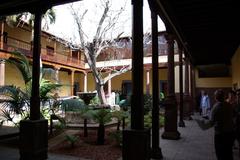Barranco de Agua de Dios: Visiting Hours, Tickets, and Travel Guide—San Cristóbal de La Laguna Historical Sites
Date: 14/06/2025
Introduction
Barranco de Agua de Dios, spanning the municipalities of San Cristóbal de La Laguna and Tegueste in northern Tenerife, is one of the island’s most important archaeological and cultural heritage sites. Declared a Bien de Interés Cultural (BIC) in 2006, this ravine preserves a remarkable concentration of Guanche habitational and funerary caves, offering deep insights into the pre-Hispanic life and rituals of Tenerife’s indigenous people. Ongoing archaeological research continues to reveal new tombs, human remains, and evidence of complex social organization (Guía Repsol; Diario de Avisos).
Barranco de Agua de Dios is more than an archaeological site—it is a living landscape where ancient traditions and modern conservation efforts intersect. Visitors can access interpretive trails, join guided tours, and engage with educational programs that highlight both the Guanche legacy and the ravine’s unique biodiversity. The site’s proximity to historic La Laguna (a UNESCO World Heritage Site) and the Anaga Rural Park makes it a must-visit for history and nature enthusiasts (Ayuntamiento de La Laguna; Tenerife Weekly News).
This comprehensive guide details visiting hours, ticketing, accessibility, cultural significance, travel tips, and frequently asked questions to help you enjoy a meaningful and responsible visit to Barranco de Agua de Dios.
Table of Contents
- Archaeological Context and Discovery Timeline
- Guanche Heritage and Cultural Significance
- Visiting Barranco de Agua de Dios: Hours, Tickets, and Accessibility
- Archaeological Features and Site Layout
- Research Methodologies and Conservation
- Visuals and Media
- Frequently Asked Questions (FAQ)
- Legal Protection and Future Prospects
- Cultural Continuity and Community Involvement
- Responsible Tourism and Visitor Guidelines
- Summary and Next Steps
- References
Archaeological Context and Discovery Timeline
Barranco de Agua de Dios is a premier archaeological landscape, renowned for its density of aboriginal Guanche habitational and funerary sites. Recognized as a BIC in 2006, the site has been the focus of conservation and systematic research for decades (Guía Repsol). Recent excavations have uncovered numerous new funerary caves and osteological remains, further enriching our understanding of the Guanche culture (Diario de Avisos).
The site’s archaeological record chronicles continuous use from the pre-Hispanic period, through the Spanish conquest, and into modern times, making it a vital reference point for studies on the indigenous societies of the Canary Islands.
Guanche Heritage and Cultural Significance
The Guanches, Tenerife’s indigenous people, used the ravine’s natural caves both as dwellings and sacred burial places. Funerary caves—often containing multiple skeletons—reveal complex mortuary rituals and beliefs about death and the afterlife. Evidence of thermal alteration on some remains suggests practices such as cremation or exposure to fire (academia.edu).
The spatial organization of caves along the ravine indicates deliberate placement linked to ritual and social structures. These findings provide invaluable data on Guanche demographics, health, diet, and funerary customs. Notably, the barranco’s significance persisted after the Conquest, with cave reuse reflecting enduring cultural memory (turismo.aytolalaguna.es).
Visiting Barranco de Agua de Dios: Hours, Tickets, and Accessibility
Opening Hours:
The site is generally open from 9:00 AM to 6:00 PM. However, hours may vary seasonally or due to ongoing archaeological work. Confirm current times via Ayuntamiento de La Laguna or Tegueste.
Tickets and Entry:
Entry is typically free. However, certain guided tours or special events may require tickets, which can be reserved online or at tourist offices in Tegueste and La Laguna.
Accessibility:
Due to rugged terrain and some steep paths, accessibility is limited for visitors with reduced mobility. Some areas near main entrances are being adapted, and further improvements are planned as part of the archaeological park’s development. For the most accessible experience, contact local tourism offices ahead of your visit.
How to Get There:
The ravine is easily reached by car or public transport from La Laguna and Tegueste. Parking is available in Tegueste, though it can be limited during peak hours. TITSA bus lines connect La Laguna and Tegueste (TITSA). Detailed directions and GPS information are listed on webtenerife.com.
Archaeological Features and Site Layout
The barranco’s steep terrain is punctuated by numerous caves and rock shelters.
Key features include:
- Funerary Caves: Multi-individual burials and evidence of ritual activity.
- Habitational Caves: Hearths, storage pits, and domestic artifacts.
- Rock Art: Occasional petroglyphs and painted motifs.
- Interpretive Trails: Marked routes with informational panels in Spanish and English.
Sectors such as El Murgaño and El Pozo are prioritized for future archaeological park development.
Research Methodologies and Conservation
Archaeologists employ traditional excavations, surface surveys, and modern non-invasive methods like photogrammetry and 3D mapping. Conservation efforts focus on stabilizing cave entrances, regulating visitor access, and preventing erosion. Local authorities enforce strict regulations to protect human remains and artifacts. Community engagement is a core part of stewardship, with educational programs and public outreach encouraging local participation (turismo.aytolalaguna.es).
Visuals and Media
High-quality images, videos, and virtual tours are available through official tourism portals, helping visitors visualize the site’s archaeological and natural features.
Sample alt text: “Entrance to Guanche funerary cave at Barranco de Agua de Dios.”
Frequently Asked Questions (FAQ)
Q: What are the visiting hours?
A: Daily from 9:00 AM to 6:00 PM, but check official sources for changes.
Q: Is there an entrance fee?
A: General access is free; guided tours may require tickets.
Q: How do I get there?
A: By car or bus from La Laguna or Tegueste; parking is available.
Q: Is the site accessible for people with disabilities?
A: Some accessible areas exist, but most terrain is rugged.
Q: Are guided tours available?
A: Yes, bookable in advance via local operators and tourist offices.
Q: What should I bring?
A: Sturdy shoes, water, sun protection, and a camera.
Legal Protection and Future Prospects
Since its BIC designation in 2006, Barranco de Agua de Dios has benefited from legal protections and a defined buffer zone (Guía Repsol). Administrative challenges, such as boundary disputes, have delayed formal establishment of the archaeological park, but local authorities remain committed to resolving these issues and enhancing visitor amenities (Diario de Avisos).
Ongoing projects include the development of an interpretation center, improved signage, and expanded educational programming.
Cultural Continuity and Community Involvement
The communities surrounding Barranco de Agua de Dios actively preserve and celebrate their heritage. Notably, the “Corazones de Tejina” festival on August 24th features elaborate heart-shaped displays, a tradition with roots in ancient fertility rites (aytolalaguna.es). Local families transmit stories and customs related to the ravine, adding an intangible dimension to the visitor experience.
Educational initiatives, including school workshops and guided walks, foster greater public awareness and stewardship (webtenerife.com).
Responsible Tourism and Visitor Guidelines
- Stay on marked trails and do not disturb caves or artifacts.
- Do not remove archaeological material or plants.
- Pets are discouraged to protect local fauna.
- Fires, camping, and drones are prohibited.
- Support community-based tourism by joining guided tours and purchasing local products (quehacerentenerife.org).
Summary and Next Steps
Barranco de Agua de Dios is one of Tenerife’s richest archaeological and cultural landscapes—home to over 100 documented Guanche sites, sacred caves, and living traditions. As conservation efforts and visitor infrastructure continue to develop, the ravine remains a unique destination for immersive learning about the island’s ancient past and vibrant present (Gobierno de Canarias).
For up-to-date information on visiting hours, tickets, and tours:
Enhance your visit:
Download the Audiala app for guided audio tours and updates. Explore related posts for more on Tenerife’s archaeological sites, and follow official tourism channels for news and tips.
References
- Guía Repsol, 2006, Cultural Heritage Listing
- Diario de Avisos, 2023, Archaeological Discoveries at Barranco de Agua de Dios
- Diario de Avisos, 2023, Archaeological Park Development in Tenerife
- Ayuntamiento de La Laguna, Heritage Information
- Tenerife Weekly News, 2024, Visitor Information for Barranco de Agua de Dios
- Gobierno de Canarias, 2023, Archaeological Park Project
- Turismo Ayuntamiento de La Laguna, 2024, Official Tourism Portal
- Web Tenerife, 2024, Cultural and Natural Heritage
- Academia.edu, Guanche Rituals and Settlement Patterns
- Que Hacer en Tenerife, Visitor Guidelines

